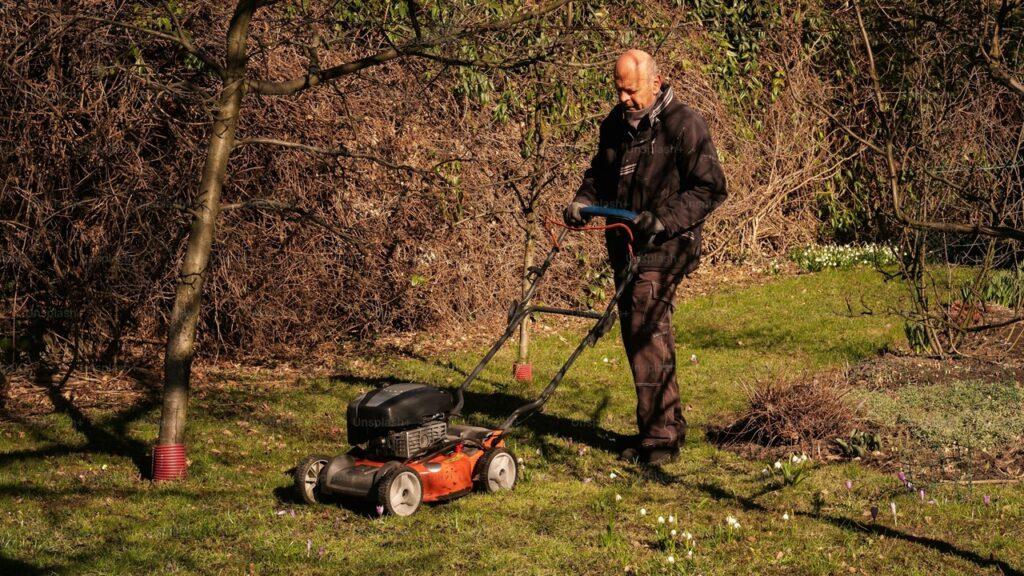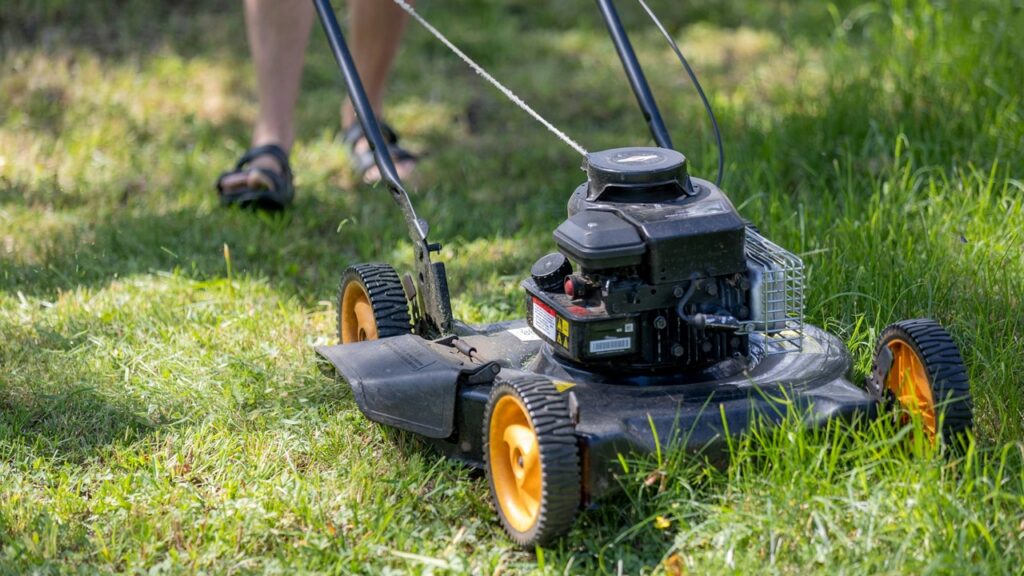
Picking the right lawn mower is easier when you know what to look for. Whether you’re mowing your first patch of grass or just replacing an old machine, knowing your options can save you time, money, and quite a bit of frustration.
In this article, we’ll walk through the basics, help you match your mower to your yard, and explain the different types of lawn mowers so you can feel confident making the right call.
What is a Lawn Mower?
A lawn mower is a machine that cuts grass to a uniform height, usually by spinning a blade or set of blades underneath a deck. Some are pushed by hand, others move on their own, and a few even mow your lawn for you while you sit back and relax.
The idea is simple, but the options are not. From manual reel mowers to ride-on models with cruise control, today’s lawn mowers cover a wide range of features, prices, and power levels. What works for a small flat yard might be a headache on a hilly half-acre.
Think of a lawn mower as your lawn’s regular barber. Some folks just need a quick trim every week or two, while others need more power to deal with fast-growing, uneven grass. The key is to find one that fits your lawn and your lifestyle.
Understand Your Lawn’s Needs First
Before diving into mower types, take a few minutes to think about your lawn. Its size, shape, and features will influence what kind of mower makes the most sense.
Start with the size. If you can mow the whole yard in under 20 minutes, a smaller mower like a reel or electric push model might be all you need.
But if you’re pushing an hour or more, especially with breaks, you’ll probably want something powered or ride-on to make things easier.
Now look at the terrain. A flat yard is easy for almost any mower. But if your lawn has steep slopes, tight corners, or lots of obstacles like trees or flower beds, maneuverability becomes more important than raw power.
Also, think about how often you mow and what your grass is like. Some grass types grow fast and thick, which means you’ll need a more powerful machine to handle it without clogging or stalling. If you only mow once every couple of weeks, you might need something with better cutting strength.
And finally, think about your own comfort. Some people are happy to push a mower around for an hour. Others might have back or shoulder issues, or just prefer an easier option. There’s no shame in picking a mower that makes life easier.
The Main Types of Lawn Mowers Explained
Lawn mowers come in all shapes and sizes. Some are quiet and simple, others are built like mini tractors. Below are the most common types you’ll find, with a breakdown to help you see which one might fit your yard and your routine.
Push Reel Mowers
These are the old-school mowers that don’t use gas or electricity. They rely on your strength to push the blades forward as they spin and cut the grass. No motor, no noise, and barely any maintenance.
Push reel mowers are perfect for small, flat lawns. If you enjoy a little workout and don’t mind taking your time, they can be surprisingly satisfying to use. Plus, they’re quiet, so no need to wake up the whole neighborhood on a Saturday morning.
They do have limits though. They don’t work well on overgrown grass or uneven terrain, and they struggle with anything more than light mowing.
Pros:
- Very low maintenance
- No fuel or battery needed
- Quiet and eco-friendly
- Lightweight and easy to store
- Budget-friendly option
Cons:
- Not great for thick or tall grass
- Requires more effort to push
- Doesn’t cut weeds or rough patches well
Electric Lawn Mowers (Corded and Cordless)
Electric mowers are a step up in convenience. Corded models plug into an outlet, while cordless ones run on rechargeable batteries. They’re quieter than gas mowers and easier to maintain, which makes them a good fit for small to medium-sized lawns.
Corded mowers are usually lighter and cheaper, but dragging a cord around can be annoying, especially if your yard has lots of turns or trees.
Cordless models offer more freedom, but they only last as long as the battery allows, which might be 30 to 60 minutes on average.
These mowers are popular for a reason. If you want something easy to start, light to push, and decent for weekly cuts, electric is a great choice.
Pros:
- Quiet and clean operation
- Easy to start and use
- No oil changes or gas needed
- Great for small to medium yards
- Lighter than gas mowers
Cons:
- Limited battery life (for cordless)
- Cord management is tricky (for corded)
- May struggle with thick or wet grass
Gas-Powered Lawn Mowers
Gas mowers are the go-to for bigger or tougher lawns. They have powerful engines that can cut through thick grass without slowing down. You can find both push and self-propelled versions, with self-propelled models helping you move forward with less effort.
They’re built to handle hills, wet grass, and anything in between. But the tradeoff is the upkeep. You’ll need to change the oil, keep gas on hand, and clean the air filter now and then. They’re also noisier and heavier than electric options.
If you don’t mind getting your hands a little dirty and want power over convenience, gas is still a solid pick.
Pros:
- Strong cutting power
- Handles larger or uneven yards well
- Works even on tall or wet grass
- Long run time
- Wide availability of models and parts
Cons:
- Noisy and emits fumes
- Needs regular maintenance
- Heavier and harder to store
Riding Lawn Mowers and Lawn Tractors
If mowing your lawn feels like a chore that takes up your whole weekend, a riding mower might be worth it. These are built for big yards, usually half an acre or more. You sit and steer, just like a small car.
They come in different styles. Some are compact and basic, while others have extra features like cup holders, headlights, or even Bluetooth. Yes, really.
The big thing to consider here is storage. These machines take up a lot of space. They also cost more than other mowers, but the time and energy they save can be a big win if your lawn justifies it.
Pros:
- Very fast and efficient for large lawns
- Comfortable to use, no pushing
- Great for uneven or sloped terrain
- Can often attach tools or accessories
- Long-lasting with proper care
Cons:
- Expensive upfront cost
- Needs lots of storage space
- Not ideal for tight corners or small lawns
Robotic Lawn Mowers
These are like Roombas for your yard. You set them up, mark the boundaries, and they quietly trim your grass on a schedule. They work best on flat, open lawns with minimal obstacles.
Setup takes a bit of time, and they aren’t cheap, but the hands-off convenience is unmatched. Some models even return to their charging station automatically when the battery runs low.
These are perfect if you hate mowing or just want to free up your weekends. But they aren’t a good fit if your lawn has steep hills, lots of debris, or if you only mow occasionally.
Pros:
- Fully automatic mowing
- Very quiet and efficient
- Saves time and effort
- Good for regular, light trims
- Some models include app control
Cons:
- High upfront cost
- Not great on slopes or uneven ground
- Setup can be time-consuming
Key Features to Consider Before Buying a Lawn Mower
Once you know what type of mower you’re leaning toward, it’s time to look at the details. These features can make a big difference in how easy the mower is to use, how well it performs, and how long it lasts.
Cutting Width and Deck Size
This tells you how wide a strip of grass the mower can cut in one pass. Wider decks get the job done faster but are harder to maneuver in tight spots. A 14 to 20-inch deck is common for small yards, while 21 inches or more is better for bigger areas.
If your lawn has narrow paths or lots of landscaping, a smaller deck gives you more control. But if you’ve got room to move and want to finish quickly, bigger is better.
Cutting Height Adjustment
This lets you choose how short or long you want your grass. Some mowers have a few fixed settings, while others offer more flexibility with single-lever or wheel-by-wheel adjustments.
Being able to change the height easily helps you deal with seasonal changes, different grass types, or just your own preference for how tidy the yard looks.
Mulching, Bagging, and Side Discharge
These are your options for what happens to the clippings. Mulching chops grass into tiny bits and returns it to the soil, which can be good for your lawn. Bagging collects it all for easy disposal. Side discharge just throws it out the side as you mow.
Some mowers let you switch between all three. Others only offer one or two options. Think about whether you like a clean look or if you’re fine leaving clippings behind.
Power Source and Runtime
Gas, corded electric, and cordless battery each have their ups and downs. Gas gives you long run time and strong power, but it’s loud and messy. Corded electric is light but limited by the cord. Battery-powered is quiet and convenient, but only lasts as long as the charge.
If you don’t like refueling or dealing with cords, a battery might be your sweet spot—just be prepared to recharge or swap batteries mid-mow for larger areas.
Ease of Use and Storage
A mower should feel manageable, not like you’re wrestling a shopping cart. Look for models that are easy to push, turn, and fold up. Features like self-propelling wheels, padded handles, and compact storage make a difference when you’re using it every week.
And don’t forget the weight. A lighter mower can make a world of difference, especially if you need to carry it over steps or move it into a tight shed.
Maintenance Needs
Some mowers are plug-and-play. Others need regular oil changes, filter replacements, or blade sharpening. Electric mowers are usually simpler, while gas models need a bit more attention.
If you’re not mechanically inclined, look for something low-maintenance. And if you’re willing to do some upkeep in exchange for power, then gas might still be worth it.
Noise Level
This might not seem important at first, but if your neighbor mows at 7 am, you know how annoying it can be. Electric mowers are much quieter than gas ones. Reel mowers are nearly silent. If peace and quiet matters to you—or your neighbors—keep noise in mind.
Top Questions to Ask Before You Buy
Before you click “buy” or head to the store, run through a few questions like these. They’ll help you avoid common regrets and make sure the mower fits your life as well as your lawn.
- How big is my yard, and how long does it usually take to mow?
- Do I want to push it or let it drive itself?
- Is storage space limited?
- Am I okay with basic maintenance, or do I want something simple?
- What kind of grass do I have, and how fast does it grow?
- How quiet does the mower need to be?
- Do I plan to mulch, bag, or just leave the clippings?
- Will I need a long cord or extra batteries?
Expert Tips for First-Time Buyers
If it’s your first time buying a mower, a little advice can go a long way. Here are a few tips that’ll save you time, money, and maybe even your back.
- Stick to what you need, not what looks cool. It’s tempting to get something fancy, but if it’s overkill for your yard, you’ll regret it.
- Check the weight and feel before you buy. If you’re shopping in-store, give it a push and lift. Some mowers look compact but feel heavy or awkward.
- Think long-term, not just price. A cheap mower that breaks in a year isn’t much of a deal. Look at reviews, parts availability, and warranty.
- Read the manual before the first mow. Sounds boring, but it helps avoid common mistakes—like forgetting to tighten the handle before starting.
- Consider your body. If you’ve got back pain or joint issues, self-propelled models or ride-ons can be a game-changer.
Conclusion
Choosing a lawn mower isn’t just about picking the most powerful or the most expensive one. It’s about finding something that fits your lawn, your comfort level, and how much time you want to spend mowing each week.
Start by understanding your lawn—its size, layout, and the kind of grass you’re dealing with. Then, take a look at the types of mowers out there and think about what suits your lifestyle best.
Some folks enjoy the simplicity of a reel mower, while others need the strength of gas or the ease of a riding model.
Don’t forget to check features like cutting width, height settings, and how the mower handles clippings. And ask yourself the real questions, like how much effort you’re willing to put in and how often you plan to mow.
Pick something that makes mowing feel less like a chore and more like a satisfying task. The right mower can turn a patchy lawn into something you’re proud of.

At our core, we’re a group of passionate yard, garden and mown enthusiasts. We dive deep into the world of backyard of your home. We try to provide as much value to the readers with our information and how to blog articles as possible along with proper information-based reviews as well.




